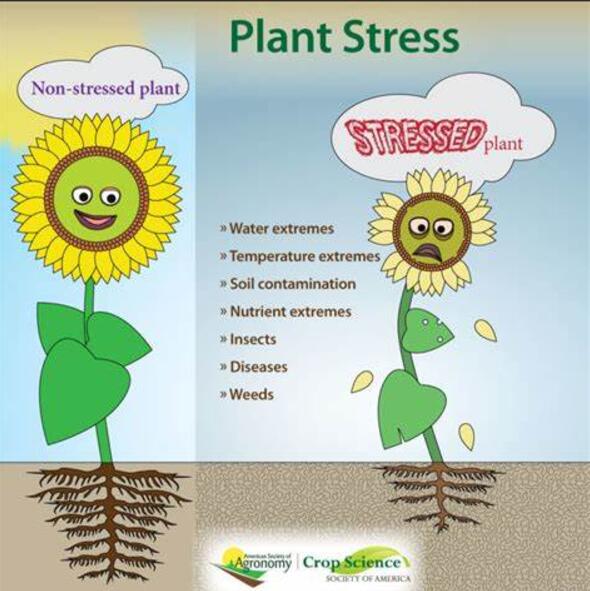Complexity of combined abiotic stresses to crop plants
IF 6.8
Q1 PLANT SCIENCES
引用次数: 0
Abstract
Plants frequently encounter combined abiotic stress factors such as heat and drought, salinity and drought, and flooding and salinity, which impact their growth, development, and productivity. These stress combinations often produce distinct physiological, biochemical, and molecular responses, requiring complex mechanisms for tolerance. We highlight the morphological adaptations (e.g., reduced leaf area, deeper roots) and biochemical responses (e.g., accumulation of osmoprotectants and antioxidants) that help plants mitigate stress effects. We emphasize the role of phytohormones such as abscisic acid, salicylic acid, and ethylene in stress signaling and molecular regulation through transcription factors and epigenetic modifications during combined stresses. Integrating advanced tools like omics technologies (transcriptomics, proteomics, metabolomics), genetic engineering (CRISPR/Cas9), speed breeding, and systems biology provides insights into stress-responsive pathways and accelerates the development of resilient crops. Additionally, nutrient management strategies (notably silicon and lesser essential nutrient supplementation), and agricultural practices like low tillage and cover cropping are also explored as strategies to improve stress tolerance. One of the least studied in combined stresses is the utilization of plant growth-promoting rhizobacteria, either single or mixed communities. These are promising approaches for promoting stress tolerance. This review underscores the need for multi-year field trials and interdisciplinary strategies to address the complexities of combined stresses and achieve sustainable crop productivity under changing climatic conditions. Future perspectives focus on designing climate-smart crops using speed breeding, synthetic biology, and machine learning.

复合非生物胁迫对作物的复杂性
植物经常会遇到热和干旱、盐和干旱、洪水和盐等非生物胁迫因素,这些因素会影响植物的生长、发育和生产力。这些应激组合通常产生不同的生理、生化和分子反应,需要复杂的耐受性机制。我们强调形态适应(例如,叶面积减少,根深)和生化反应(例如,渗透保护剂和抗氧化剂的积累)有助于植物减轻胁迫效应。我们强调植物激素如脱落酸、水杨酸和乙烯在联合胁迫下通过转录因子和表观遗传修饰参与胁迫信号和分子调控中的作用。整合先进的工具,如组学技术(转录组学、蛋白质组学、代谢组学)、基因工程(CRISPR/Cas9)、快速育种和系统生物学,提供了对应激反应途径的见解,并加速了抗逆性作物的发展。此外,还探讨了营养管理策略(特别是硅和较少必需营养素补充)和农业实践(如低耕和覆盖种植)作为提高抗逆性的策略。在联合胁迫中研究最少的是植物生长促进菌群的利用,无论是单一还是混合群落。这些都是促进压力耐受性的有希望的方法。这篇综述强调了多年田间试验和跨学科战略的必要性,以解决复合胁迫的复杂性,并在不断变化的气候条件下实现可持续的作物生产力。未来的研究重点是利用快速育种、合成生物学和机器学习来设计气候智能型作物。
本文章由计算机程序翻译,如有差异,请以英文原文为准。
求助全文
约1分钟内获得全文
求助全文
来源期刊

Plant Stress
PLANT SCIENCES-
CiteScore
5.20
自引率
8.00%
发文量
76
审稿时长
63 days
期刊介绍:
The journal Plant Stress deals with plant (or other photoautotrophs, such as algae, cyanobacteria and lichens) responses to abiotic and biotic stress factors that can result in limited growth and productivity. Such responses can be analyzed and described at a physiological, biochemical and molecular level. Experimental approaches/technologies aiming to improve growth and productivity with a potential for downstream validation under stress conditions will also be considered. Both fundamental and applied research manuscripts are welcome, provided that clear mechanistic hypotheses are made and descriptive approaches are avoided. In addition, high-quality review articles will also be considered, provided they follow a critical approach and stimulate thought for future research avenues.
Plant Stress welcomes high-quality manuscripts related (but not limited) to interactions between plants and:
Lack of water (drought) and excess (flooding),
Salinity stress,
Elevated temperature and/or low temperature (chilling and freezing),
Hypoxia and/or anoxia,
Mineral nutrient excess and/or deficiency,
Heavy metals and/or metalloids,
Plant priming (chemical, biological, physiological, nanomaterial, biostimulant) approaches for improved stress protection,
Viral, phytoplasma, bacterial and fungal plant-pathogen interactions.
The journal welcomes basic and applied research articles, as well as review articles and short communications. All submitted manuscripts will be subject to a thorough peer-reviewing process.
 求助内容:
求助内容: 应助结果提醒方式:
应助结果提醒方式:


